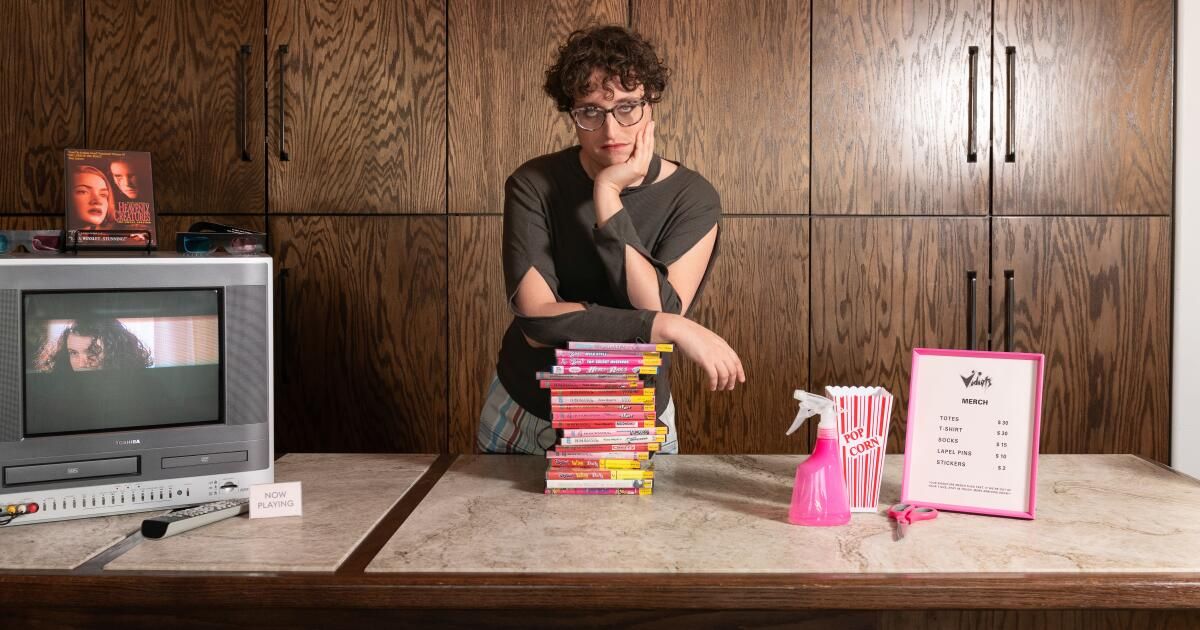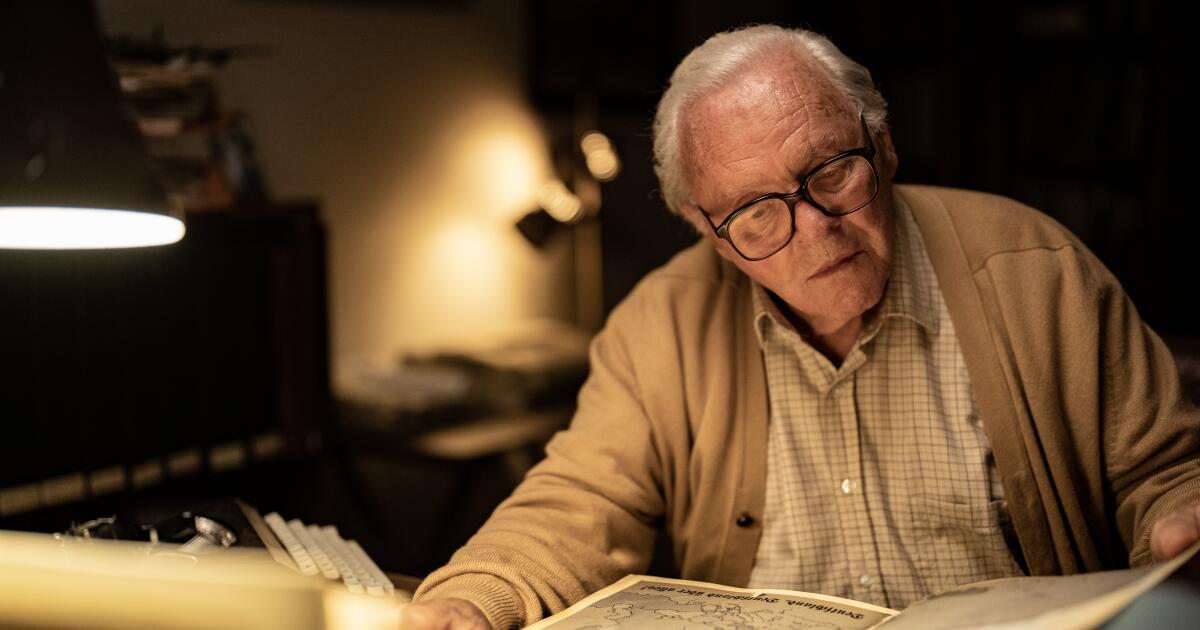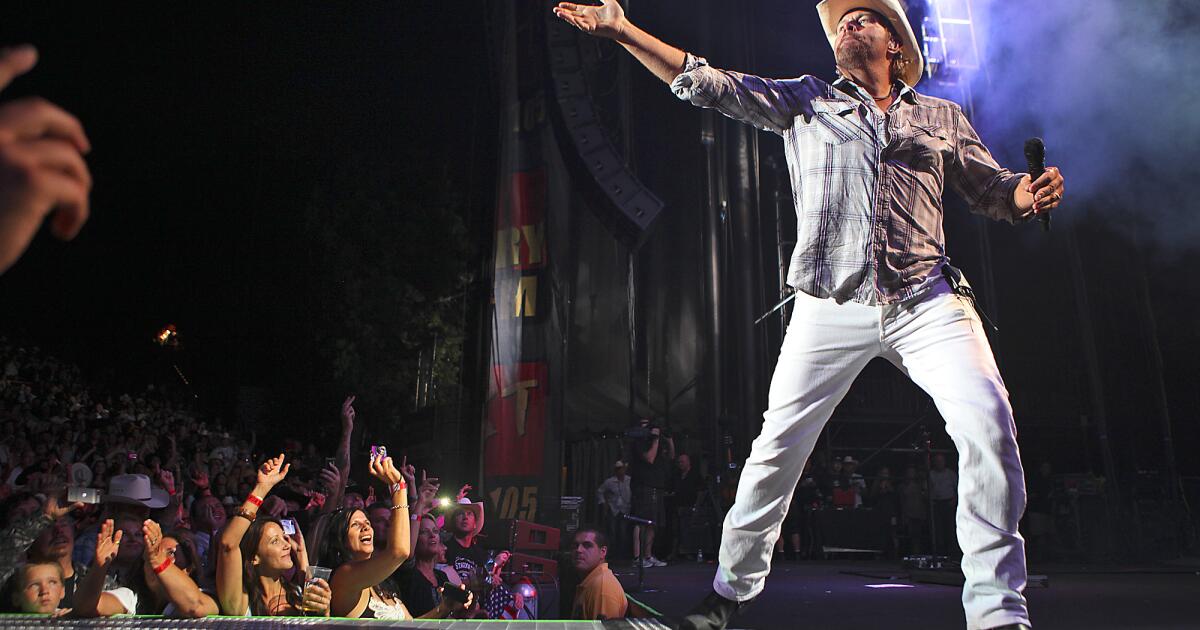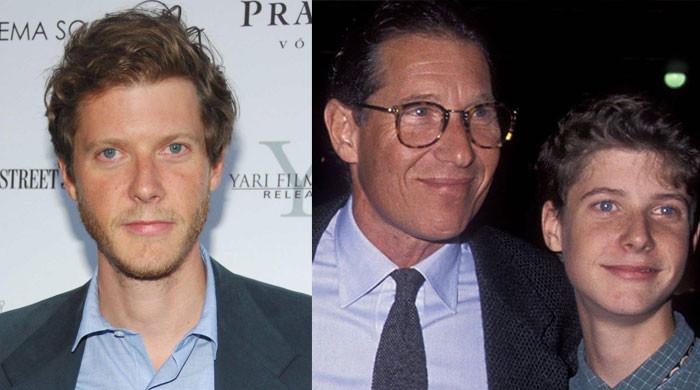Penélope Cruz stares at me as I interview visionary filmmaker Jane Schoenbrun.
The Spanish actress is not in the room with us, but on the cover of the DVD of her 2015 film “Ma Ma,” sitting on a shelf at Vidiots, the legendary Los Angeles video store that was resurrected last year in Eagle Rock. Schoenbrun and I have hidden away in one of its film-filled hallways to talk about the power of browsing, perhaps to watch Cruz or to be drawn into some other new obsession.
“I was a kid who was into video games,” says Schoenbrun, 37. “There is a churchy feeling to being surrounded by these sacred objects that is very childish to me.”
Schoenbrun’s beguiling trans-themed work “I Saw the TV Glow” (opening Friday) had its Los Angeles premiere at this physical media sanctuary last month as part of the first-ever Los Angeles Film Festival . The filmmaker marvels at the rows of records, thousands of them. “There is something hidden here that could transport me to a new place or change my life,” Schoenbrun says.
Immersed in fiction is where the teenage protagonists of “I Saw the TV Glow” feel most comfortable. It's the '90s and Owen (Justice Smith) and Maddie (Brigette Lundy-Paine), two quiet high schoolers, bond over a fantastic show, “The Pink Opaque.”
Justice Smith, left, and Brigette Lundy-Paine in the film “I Saw the TV Glow.”
(A24)
Each episode follows a pair of superpowered teenagers fighting monsters unleashed by the villain Mr. Melancholy. Although physically separated, the show's heroes share a telepathic connection. Digital noise and silly effects convincingly evoke the era, and Schoenbrun elevates each segment seemingly through a time machine. He captures teenage angst perfectly: a little cheesy and serious, but sincere.
“The Pink Opaque” airs on Saturday nights after Owen's bedtime, but over the next few years, Maddie records it on VHS tapes for him. It becomes a shared language between these two soft-spoken outcasts, a language only they can hear. She frees them from their reality and torments them. Maybe they are living in the wrong bodies, in the wrong city, and time is slipping away.
“The film is interested in the sadness, the loneliness, or perhaps even the sinister nature of investing so deeply emotionally in the fandom,” Schoenbrun says, likening it to a two-way mirror. Hypnotic and set to music by folktronic artist Alex G with an appearance by musician Phoebe Bridgers, “I Saw the TV Glow” has its own transportive pause. But though carefully stylized, Schoenbrun's film still feels like a story “created from the ribcage,” as star Lundy-Paine describes it.
“When I remember reading the script for the first time, I felt like a wave of electric blue and pink and a sense of urgency came over me,” Lundy-Paine says during a video call.
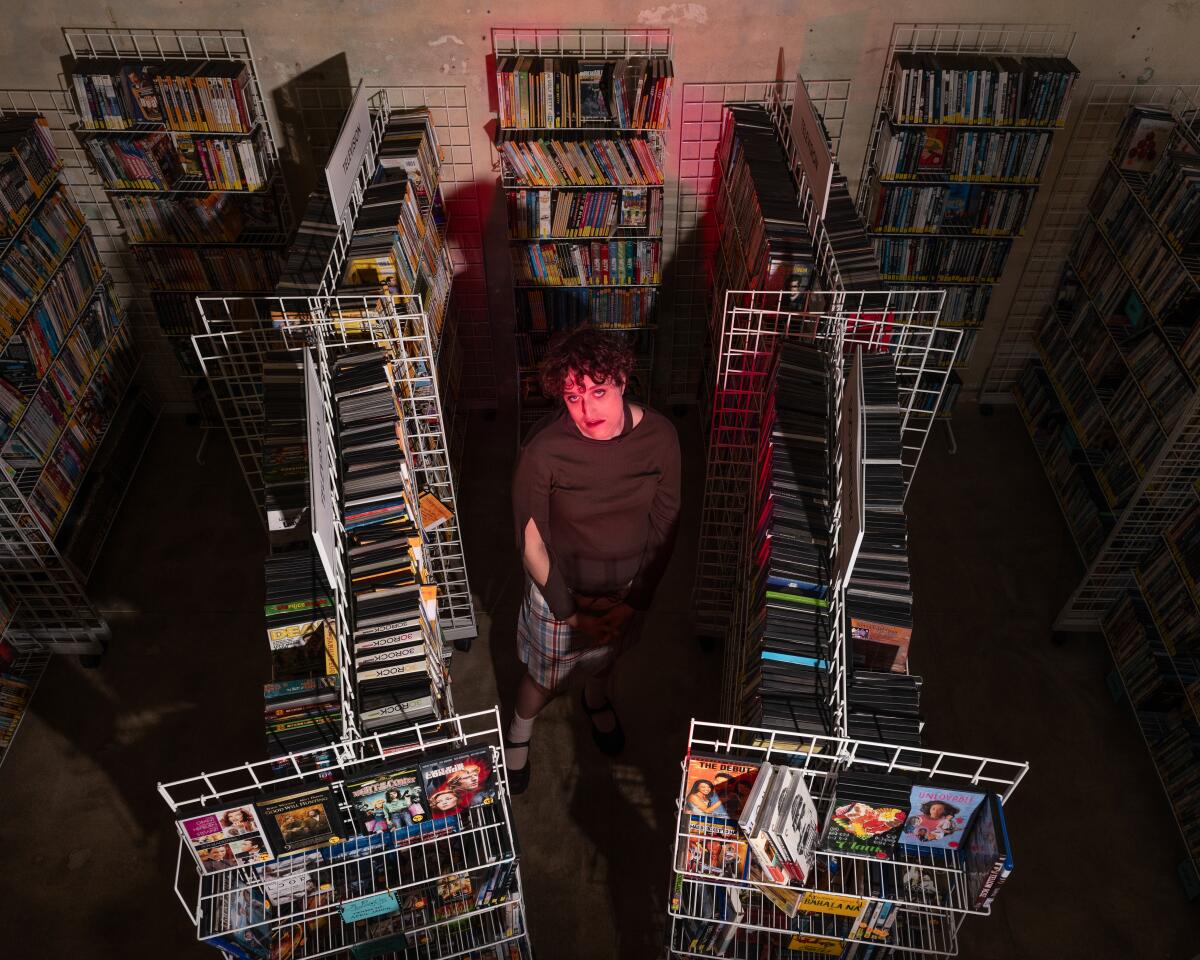
Jane Schoenbrun, director of “I Saw The TV Glow,” at Vidiots in Eagle Rock in April.
(In Monforte / For The Times)
When she was 10, Schoenbrun stumbled upon the supernatural series “Buffy the Vampire Slayer” on an old television in her parents' bedroom. The program became the fundamental reference for “The Pink Opaque” and, for a young fan, a place of belonging. At one point, Schoenbrun was able to name each episode, by title and in chronological order, to help them fall asleep.
“It was a show about a girl who wasn't like the others and who had a destiny she didn't want to have because she wanted to feel normal,” Schoenbrun says. “It was about finding a family and people changing. “I found the way the characters were formed very comforting.”
In retrospect, the director now understands why an episode in which Buffy tells her mother that she is a vampire slayer moved them to tears.
“It resonated because I was hungry, like the characters in my film, for something fictional that felt real,” Schoenbrun says, “like it was telling me a secret.” Some years later they would realize that this secret was his identity as a trans person.
“Now I exist in spaces full of people I love, but when I was a kid, 100% of that love went straight to 'Buffy'; I cared a lot about those characters,” Schoenbrun says. (Which episode have you seen the most times? “Once More, With Feeling,” also known as the musical “Buffy.”)
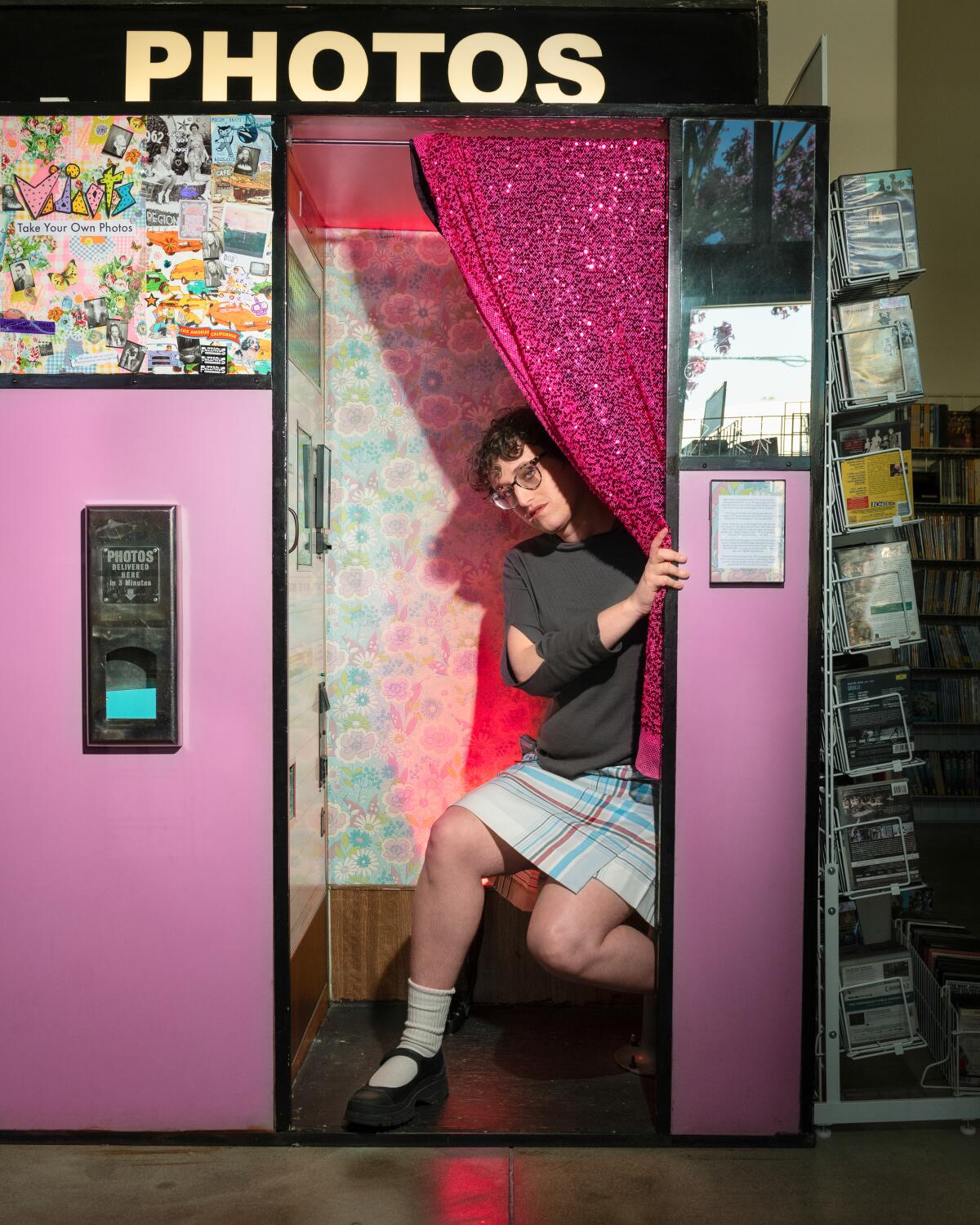
Director Jane Schoenbrun, photographed at Vidiots in Eagle Rock in April.
(In Monforte / For The Times)
Schoenbrun's devotion to “Buffy” extended to online forums where others shared feelings of being under her spell. It inspired Schoenbrun’s first feature of 2021, “We’re All Going to the World’s Fair,” about an isolated teenager, Casey (Anna Cobb), whose only outlet for self-discovery is creepypasta, the ever-evolving horror fiction endemic to the Internet. and the community that surrounds it.
“Casey feels dissociated from everyone,” Cobb tells me over Zoom, calling her character a “rejectable reject,” someone sinking into a digital abyss. She “she Not even she could find a group of weird kids that she felt good with. That's why the Internet was a kind of safe harbor for her, although it was also harmful to her.”
Like Owen and Maddie, Casey sees the glow of the computer monitor and longs to find answers in an alternate reality.
“I didn't know I was trans when I started working on that film,” Schoenbrun says. “It really was like Casey searching for something and thinking, 'What is this feeling?' And coming back to this space of 'Why did I feel so drawn to these online spaces where I was able to experiment with myself in a way separate from physical form and identity?'”
“TV Glow,” on the other hand, was written immediately after Schoenbrun came to terms with her gender dysphoria. For the filmmaker, it is an acknowledgment of the countless invisible signals that arrived before they were fully understood.
“It is very rare in this world when there is actually an answer or a cure for a problem that has always been assumed to be just the human condition,” Schoenbrun says. “It's not that transition solves all of life's existential problems, but it certainly solved some of them for me.”
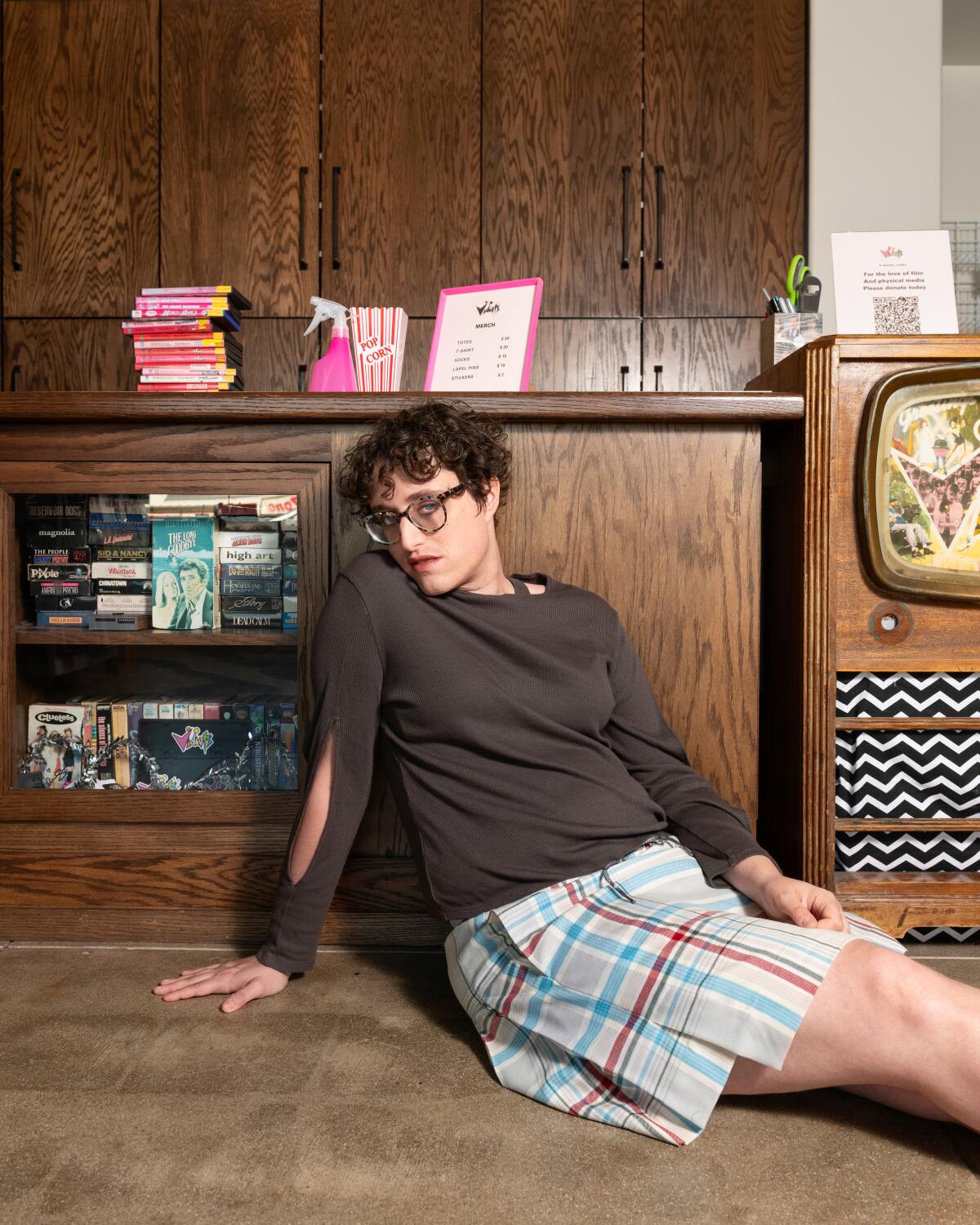
Director Jane Schoenbrun, photographed at Vidiots in Eagle Rock in April.
(In Monforte / For The Times)
Lundy-Paine, who also identifies as non-binary, sees “I Saw the TV Glow” as a record of the “pain and devastation” a trans person endures while becoming aware of “the prison that has been built around you, and knowing the enormity of the work that will be necessary to free oneself from this prison.”
“Trans girls are at risk,” says Schoenbrun. “We come into post-transition life thinking, 'I have to make up for a lot of lost time.'”
Schoenbrun knows that part of that alienation came from growing up in the suburbs of Westchester County, New York, “perfectly manicured” spaces of homogeneity. In a scene from the finale of “TV Glow,” which was filmed in New Jersey, Owen is seen working in an arcade, the Fun Center, surrounded by smiling faces. Although they perceive it as a place of harmless enjoyment, for Owen it is another cage that suffocates him.
“The suburbs are a very strange place where it's business as usual,” Schoenbrun says. “When you're a child born there and you're told this is normal and safe, but then maybe you're not as normative and you don't fit as clearly into it, it's just a very strange experience.”
However, there was Captain Video, a video store crucial to Schoenbrun's formative years as a cinephile, where they discovered titles like “Donnie Darko” and “Eternal Sunshine of the Spotless Mind.” Those indies from the beginning of the years felt transgressive.
Hailed as an instant cult film since its premiere at Sundance, “TV Glow” has already resonated with viewers, perhaps even in the same way Schoenbrun did with “Buffy.” Online forums and fan fiction about Owen and Maddie, if they aren't already happening on social media, are imminent, as is discussion of Schoenbrun's ending, which is impossible to spoil even as it conveys notes of hope and fear to the time.
“Maybe it's me exploring my relationship with myself and not wanting to play with the idea of resolution or catharsis typical of Hollywood, of Western narrative, which allows us to close an experience or a book,” says Schoenbrun. “Because for me the transition lasts a lifetime. And actually, I don't know if I like the word transition. “I like the word healing.”
As we emerge from our Vidiots hideout, Schoenbrun notices, with a kind of quiet excitement that I'm beginning to see as uniquely theirs, that we were sitting next to sections dedicated to queer pioneer Gregg Araki and genre-defying French author Olivier Assayas. One day, not too far away, Schoenbrun will have a space on the Vidiots shelves, filled with titles ready to change someone's life, or at least make them feel less alone.

